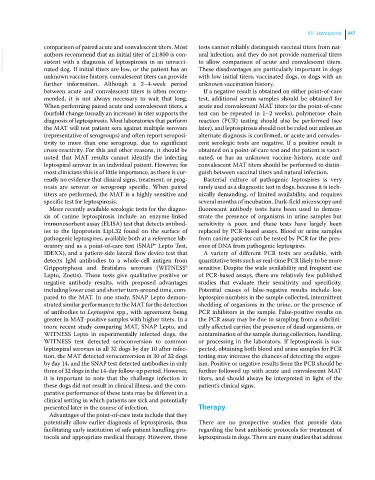Page 1009 - Clinical Small Animal Internal Medicine
P. 1009
101 Leptospirosis 947
comparison of paired acute and convalescent titers. Most tests cannot reliably distinguish vaccinal titers from nat-
VetBooks.ir authors recommend that an initial titer of ≥1:800 is con- ural infection, and they do not provide numerical titers
to allow comparison of acute and convalescent titers.
sistent with a diagnosis of leptospirosis in an unvacci-
nated dog. If initial titers are low, or the patient has an
with low initial titers, vaccinated dogs, or dogs with an
unknown vaccine history, convalescent titers can provide These disadvantages are particularly important in dogs
further information. Although a 2–4‐week period unknown vaccination history.
between acute and convalescent titers is often recom- If a negative result is obtained on either point‐of‐care
mended, it is not always necessary to wait that long. test, additional serum samples should be obtained for
When performing paired acute and convalescent titers, a acute and convalescent MAT titers (or the point‐of‐care
fourfold change (usually an increase) in titer supports the test can be repeated in 1–2 weeks), polymerase chain
diagnosis of leptospirosis. Most laboratories that perform reaction (PCR) testing should also be performed (see
the MAT will test patient sera against multiple serovars later), and leptospirosis should not be ruled out unless an
(representative of serogroups) and often report seroposi- alternate diagnosis is confirmed, or acute and convales-
tivity to more than one serogroup, due to significant cent serologic tests are negative. If a positive result is
cross‐reactivity. For this and other reasons, it should be obtained on a point‐of‐care test and the patient is vacci-
noted that MAT results cannot identify the infecting nated, or has an unknown vaccine history, acute and
leptospiral serovar in an individual patient. However, for convalescent MAT titers should be performed to distin-
most clinicians this is of little importance, as there is cur- guish between vaccinal titers and natural infection.
rently no evidence that clinical signs, treatment, or prog- Bacterial culture of pathogenic leptospires is very
nosis are serovar or serogroup specific. When paired rarely used as a diagnostic test in dogs, because it is tech-
titers are performed, the MAT is a highly sensitive and nically demanding, of limited availability, and requires
specific test for leptospirosis. several months of incubation. Dark‐field microscopy and
More recently available serologic tests for the diagno- fluorescent antibody tests have been used to demon-
sis of canine leptospirosis include an enzyme‐linked strate the presence of organisms in urine samples but
immunosorbent assay (ELISA) test that detects antibod- sensitivity is poor, and these tests have largely been
ies to the lipoprotein LipL32 found on the surface of replaced by PCR‐based assays. Blood or urine samples
pathogenic leptospires, available both at a reference lab- from canine patients can be tested by PCR for the pres-
oratory and as a point‐of‐care test (SNAP® Lepto Test, ence of DNA from pathogenic leptospires.
IDEXX), and a patient‐side lateral flow device test that A variety of different PCR tests are available, with
detects IgM antibodies to a whole‐cell antigen from quantitative tests such as real‐time PCR likely to be more
Grippotyphosa and Bratislava serovars (WITNESS® sensitive. Despite the wide availability and frequent use
Lepto, Zoetis). These tests give qualitative positive or of PCR‐based assays, there are relatively few published
negative antibody results, with proposed advantages studies that evaluate their sensitivity and specificity.
including lower cost and shorter turn‐around time, com- Potential causes of false‐negative results include low
pared to the MAT. In one study, SNAP Lepto demon- leptospire numbers in the sample collected, intermittent
strated similar performance to the MAT for the detection shedding of organisms in the urine, or the presence of
of antibodies to Leptospira spp., with agreement being PCR inhibitors in the sample. False‐positive results on
greater in MAT‐positive samples with higher titers. In a the PCR assay may be due to sampling from a subclini-
more recent study comparing MAT, SNAP Lepto, and cally affected carrier, the presence of dead organisms, or
WITNESS Lepto in experimentally infected dogs, the contamination of the sample during collection, handling,
WITNESS test detected seroconversion to common or processing in the laboratory. If leptospirosis is sus-
leptospiral serovars in all 32 dogs by day 10 after infec- pected, obtaining both blood and urine samples for PCR
tion, the MAT detected seroconversion in 30 of 32 dogs testing may increase the chances of detecting the organ-
by day 14, and the SNAP test detected antibodies in only ism. Positive or negative results from the PCR should be
three of 32 dogs in the 14‐day follow‐up period. However, further followed up with acute and convalescent MAT
it is important to note that the challenge infection in titers, and should always be interpreted in light of the
these dogs did not result in clinical illness, and the com- patient’s clinical signs.
parative performance of these tests may be different in a
clinical setting in which patients are sick and potentially
presented later in the course of infection. Therapy
Advantages of the point‐of‐care tests include that they
potentially allow earlier diagnosis of leptospirosis, thus There are no prospective studies that provide data
facilitating early institution of safe patient handling pro- regarding the best antibiotic protocols for treatment of
tocols and appropriate medical therapy. However, these leptospirosis in dogs. There are many studies that address

